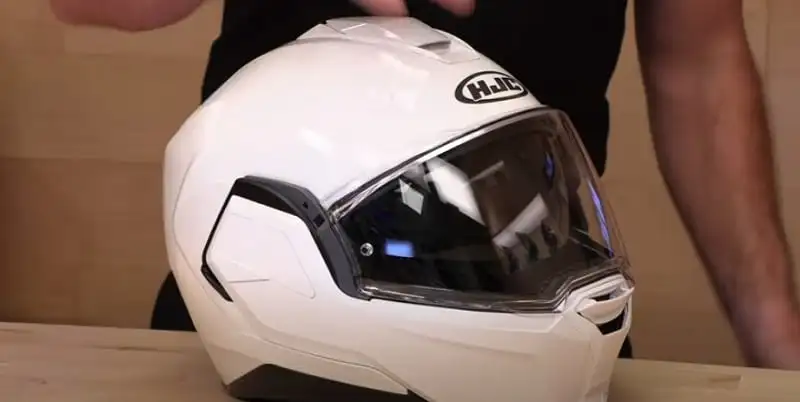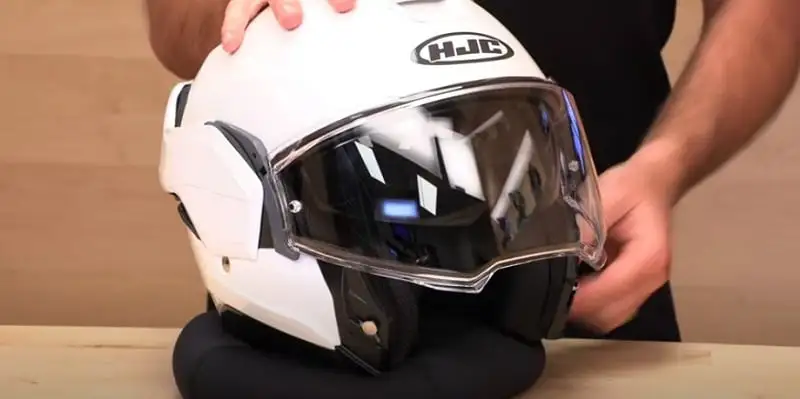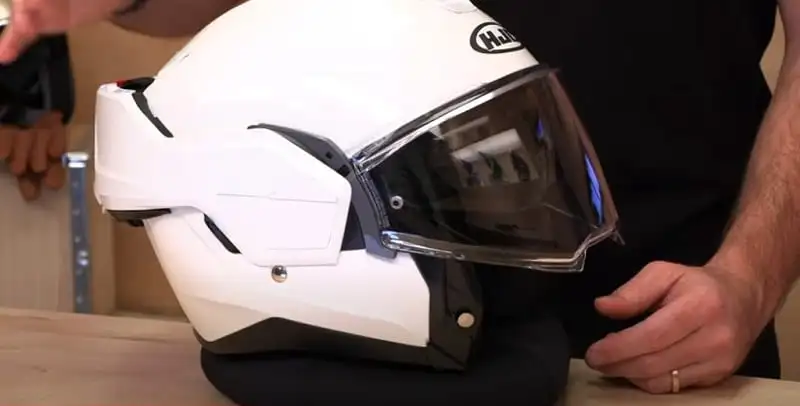The HJC i100 is the first convertible or flip-over helmet to land with a certification to the new ECE 22.06 safety standard.
It’s HJC’s i100, and it’s also their first flip-over, so it’s been interesting to see how it stacks up to the brands that already have a helmet of this type on the market.
I’ve spent about 300 miles in this one, so I can run you through the essential info and give you an idea of what I think of it in use.

HJC i100 Helmet Features
HJC i100 Shell Construction
The shell is made from polycarbonate, and a size medium i100 weighs 1925 grams. HJC calls this helmet “lightweight,” but our scales call it the second heaviest of the 87 helmets we’ve weighed since we started writing these reviews.
Thankfully, that weight is quite well balanced, and I can’t criticize how it felt on my head while I was riding, but I think it’s a bit cheeky to call it lightweight. Considering this is HJC’s first flip-over helmet, they’ve done a good job of the operating mechanism.
HJC i100 Chin Bar
Pushing the red lever at the base of the chinbar releases it, and it can slide back to the back of the shell. There are two main benefits of this design over a regular flip-front:
1. First, the weight balance and aerodynamics are better because when it’s at the back, the helmet isn’t top-heavy, and the chinbar isn’t sat in the airflow as it would be if you had the chinbar positioned on the top of the helmet.
2. Secondly, you use the main visor when the chin bar’s open, and on a normal flip, you can only have the visor down when the chinbar is closed.
This helmet has something that other flip-over helmets don’t have – it’s got a self-closing visor.
On other flip-over helmets, when you flip the chinbar up or down, you’ll always end up with the visor in the raised position.
Still, on the i100, you’ll end up with the visor down as it automatically lowers at the end of the chin bar’s travel in either direction.
The i100 is dual-homologated, so it’s tested as a full-face with the chinbar closed and an open-face with the chinbar Open.
There’s a red lever to fix it in the open position, it’s just on the side of the helmet, and I’m told that this is a requirement of the ECE 22.06 standard.
This sliding red tab holds it back, which I didn’t find easy to use while riding. But in reality, I don’t see anyone locking the chinbar back on this helmet, whatever the legal issues.
So the chances of that chinbar swinging forward of its own accord are tiny, and the chances of ever getting in trouble for riding with it back and unlocked, I would say, even smaller than that.
HJC has also added skirts on the base of the chinbar, which pops out when you lift it. They stop air flowing between the shell and the chinbar when it’s in the back position, and there’s also a chin curtain, which has the same effect as blocking off draughts when riding with the chinbar down.
On some flip-up helmets, the chin curtain gets in the way of operating the chinbar release… However, I didn’t find that to be the case with this helmet; it never got in the way once.
HJC i100 Ventilation
There’s one large scoop on the chinbar that opens in two stages, and it sends air through inlets in the chinbar, then it comes through the top of the chinbar and through to the inside. So I could feel the air flowing from that when it was open.
The top vent allows air to enter through two inlets, and because it also opens in two stages, you can have it half-open for a little less airflow.
Once air gets inside, channels are sculpted in the EPS impact liner that lets it circulate towards the back of the lid and through three exhaust vents.
Because these sit just above the chinbar when it’s in its back position, the air can still escape even when the helmet’s in open-face mode. I found the top vent to work nicely, although it doesn’t allow air to flow as strongly as the chin vent.
HJC i100 Visor

The visor has two lowering and lifting tabs located on the bottom of the visor. As it lowers, there aren’t any graduated steps for the visor, but you can leave it slightly open to allow some air to flow in.
I found it better to click the visor completely closed by pushing down on the middle of the top edge rather than using those tabs.
HJC i100 Pinlock Anti-Fogging
The visor is protected against mist by a Pinlock insert. It comes in the box with the helmet, and it’s a Pinlock 70, so it’s the middle in terms of protection, and it worked fine in my time with the lid.
In addition, the pins can easily be adjusted o alter the tension of the insert, which isn’t the case on all helmets.
HJC i100 Sun Visor
There’s a sun visor on this lid, too. It operates on a slider on the left of the lid that I found easy and intuitive to use. Now, something I’ve not seen on any other helmet, though-there, ‘s an adjuster wheel for the sun visor drop.
It’s located just inside the eye-port, with two marks on it. Rotating adjusts the amount of drop. Set it to the biggest drop, and the bottom edge will sit seven millimeters lower than if it’s set at the minimum, so you use those marks to use that wheel to set the amount of drop that you prefer.
That sun visor has an anti-fog coating, and that’s always my preference. Some say coating the sun visor reduces optical quality, which is why some brands don’t do it, but I didn’t notice any reduction in optical clarity for this having a coating.
HJC i100 Interior
The comfort lining is fully removable, and it’s a dead easy job to take it out and put it back in.
The fabric covering that inner lining is nice and soft against the skin, and it worked well in hot weather, which was handy for me as I tested this helmet through a 15-day heatwave.
In common with virtually every flip-front helmet available, the strap fastener is a micrometric buckle.
HJC i100 Communications

Behind the lining, there’s full integration capability for an intercom. It’s rigged out for HJC’s Smart intercom range, which will be the neatest fitment, but that capability doesn’t block out universal comms systems if that’s what you prefer.
I fitted a Cardo Packtalk Edge to this helmet, and it was fine, but the main appeal, I would say, to the dedicated system would be the way the microphone mounts into the helmet.
I had to mount the regular boom mic from the Cardo system so near the mouth that the boom brought it to the right-hand side of the opening.
It worked, and there’s no need to go for the HJC system if you already have something else or prefer something else. The speaker recesses are well-sized and have room for either Sena or Cardo speakers.
When I put the 40mm Cardo speakers in there, they fit inside completely, and the 45mm ones will go in there as well, although they will sit slightly proud of the recess.
HJC i100 Shell Sizes
The i100 comes in sizes from XS up to double XL. There are three shell sizes for that range. The smallest takes in lid sizes XS and S, the middle covers M and L helmets, and the biggest shell is for XL and double XL helmets.
I normally wear a medium, but I’m finding I need to go up a size in an increasing number of HJC helmets, including this one.
The medium wasn’t too bad when I tried it on with the chinbar open, but as soon as I closed it, the helmet compressed around my temples, so I needed to go up a size.
The large was fine while I was riding, but I think fitting the thicker cheek pads from the medium helmet would have made the fit better. Replacement cheek pads are available separately if you find you have a similar issue to me.
HJC i100 Safety Certification
On the front of the approval, the i100 is approved to ECE 22.06, which is gradually being phased in to replace the outgoing 22.05.
As part of that certification, test impacts are made across a wider helmet area and various impact speeds.
They’re also tested to see how they cope with glancing blows and the standard test for direct hits.
In my opinion, that new standard is better and gives more confidence in the protection level from a helmet that meets it.
As I said at the beginning, the i100 is dual-homologated, so it’s been tested as an open-face with the chinbar back and a full-face with the chinbar down.
It’s not ACU-approved for track use, though anyone who wanted to use an i100 for that would probably need their head examined anyway.
In addition, it’s not yet been rated by the UK government’s SHARP impact testing program.
After spending 300 miles or so in this helmet, I think it’s a decent option if you’re after a flip-over helmet. I’ve mostly worn it for commutes of about 35 miles, and the most time I’ve spent in this lid at any one time is about 90 minutes.
I found it comfortable throughout that, and it didn’t leave me feeling any neck ache either. However, when I tested a similar lid a few years ago on tour, I found the weight did give me neck strain after a few days in the saddle.
I can’t say for sure that this helmet would do that. It wouldn’t be fair, but that 1900g weight would concern me for day-long rides over a week or so.
The chinbar mechanism works well, the visor’s good, and the ventilation is very good, especially that chin vent.
I like the lining inside, and it’s also easy enough to fit an intercom of your choice, which is a plus. That ECE 22.06 certification is another plus point, as no other helmet of this type has that certification as we record this.
As we write this, the i100 costs around $320, which puts it pretty much on par with most of its flip-over rivals and a little bit cheaper than the Shark options.
In Conclusion
The HJC i100 is the perfect choice for all motorcyclists and ATV enthusiasts. Its advanced polycarbonate composite shell is lightweight and strong, while the advanced ventilation system keeps riders cool and comfortable during intense riding.
Its pinlock-ready HJ-36 face shield allows riders to quickly attach and remove their visor without taking off their helmet, and the quick and secure shield ratchet system ensures the shield stays securely in place.
For added safety, this helmet is DOT approved and features a rotational chinbar that allows you to adjust the chinbar to fit perfectly.
The removable and washable crown and cheek pads are soft foam to prevent pressure points and keep riders comfortable.
Where To Buy
| Model | Revzilla |
|---|---|
| HJC i100 Modular | From $320 |


